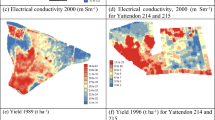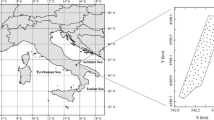Abstract
Sensed and soil sample data are used in two approaches for mapping soil properties in precision agriculture: management zone (MZs) and contour maps. This is the second paper in a two-part series that focuses on contour maps. Detailed and accurate contour maps of soil properties for precision agriculture are often costly to produce because of the large sampling effort required. Such maps or those of sensed ancillary data are often simplified to represent MZs. This research investigated the accuracy of detailed maps of soil properties produced inexpensively from sensed data by transforming them to z-scores. The z-scores of ancillary values are then transformed to values of soil variables using the mean and standard deviation of a small soil data set. The errors from this mapping approach are examined with historic soil data from three field sites with different scales of spatial variation in the United Kingdom. Errors from the conversion of z-scores of sensed data to soil variable ranges are compared with those from MZ averages (Paper I in this series). For soil properties with a moderate relation to ancillary data, the errors related to the z-score conversion were small irrespective of sample size. The root mean squared errors associated with the MZ mean rather than values from the digital map were generally smaller except when sample size was very small. The results suggest that when the scale of variation is small and more samples are required to define MZs, calibrating z-scores of sensed ancillary data may provide better MZ averages than sampling on a grid; it also provides a detailed map of spatial variation within the field. The z-score conversion approach is less sensitive to sample size and captures small features of the variation compared to the standard 100 m grid sampling to determine MZ averages.




Similar content being viewed by others
Data availability
The data used in this study are not publically available but interested parties contact the corresponding author to discuss data availability.
References
Adamchuk, V. I., Biswas, A., Huang, H., Holland, J. E., Taylor, J. A., Stenberg, B., Wetterlind, J., Minasny, B., Fidelis, C., Yinil, D., Sanderson, T., Snoeck, D., & Field, D. J. (2021). Soil sensing. In R. Kerry & A. Escolà (Eds.), Sensing approaches for precision agriculture (p. 415). Springer Nature.
Adamchuk, V. I., Hummel, J. W., Morgan, M. T., & Upadhyaya, S. K. (2004). On-the-go soil sensors for precision agriculture. Computers and Electronics in Agriculture, 44(1), 71–91.
Bishop, T. F. A., & McBratney, A. B. (2001). A comparison of prediction methods for the creation of field-extent soil property maps. Geoderma, 103, 149–160.
Christensen, S., Dyrmann, M., Laursen, M. S., Jørgensen, R. N., & Rasmussen, J. (2021). Sensing for weed detection. In R. Kerry & A. Escolà (Eds.), Sensing approaches for precision agriculture (p. 415). Springer Nature.
Farid, H. U., Bakhsh, A., Ahmad, N., Ahmad, A., & Mahmood-Khan, Z. (2016). Delineating site-specific management zones for precision agriculture. Journal of Agricultural Science, 154, 273–286.
Fordham, S. J. (1985). Soils of crowmarsh battle farms. Soil Survey of England and Wales
Franzen, D. (2023). Developing zone soil sampling maps NDSU extension, SF1176-2. https://www.ndsu.edu/agriculture/sites/default/files/2023-03/sf1176-2.pdf
Fridgen, J. J., Kitchen, N. R., Sudduth, K. A., Drummond, S. T., Wiebold, W. J., & Fraisse, C. W. (2004). Management zone analyst (MZA) software for subfield management zone delineation. Agronomy Journal, 96(1), 100–108.
Frogbrook, Z. L., Oliver, M. A., & Derricourt, K. E. (2003). Exploring the spatial relations between soil properties and electro-magnetic Induction (EMI) and the implications for management. In J. V. Stafford & A. Werner (Eds.), Precision agriculture (pp. 217–222). Wageningen Academic Publishers.
Godwin, R. J., & Miller, P. C. H. (2003). A review of the technologies for mapping within-field variability. Biosystems Engineering, 84, 393–407.
Goovaerts, P., & Kerry, R. (2010). Using ancillary data to improve prediction of soil and crop attributes in precision agriculture. In M. Oliver (Ed.), Geostatistical applications for precision agriculture. Springer.
Heming, S. (1997). Soil survey and soil data base of part of Westridge Farm and Mapletons Farm for Yattendon Estates. Soil Services Limited.
Hummel, J. W., Gaultney, L. D., & Sudduth, K. A. (1996). Soil property sensing for site-specific crop management. Computers and Electronics in Agriculture, 14, 121–136.
IBM Corp. (2021). IBM SPSS statistics for windows, version 28.0. Armonk.
IUSS Working Group WRB. (2015). World Reference Base for Soil Resources 2014, update 2015 International soil classification system for naming soils and creating legends for soil maps. FAO.
Jacquez, G. M., Goovaerts, P., Kaufmann, A., & Rommel, R. (2014). SpaceStat 4.0 user manual: Software for the space-time analysis of dynamic complex systems (4th ed.). BioMedware.
Kerry, R. (2004). Determining the effect of parent material and topography on the structure of spatial variation in soil properties for precision agriculture. University of Reading.
Kerry, R., & Escolà, A. (2021). Sensing approaches for precision agriculture (p. 415). Springer Nature.
Kerry, R., Ingram, B., Oliver, M. A. & Frogbrook, Z. L. (2024). Soil sampling and sensed ancillary data requirements for soil mapping in precision agriculture I. Delineation of management zones to determine zone averages of soil properties.
Kerry, R., & Oliver, M. A. (2003a). Co-kriging when the soil and ancillary data are not co-located. In J. V. Stafford & A. Werner (Eds.), Precision agriculture (pp. 303–308). Wageningen Academic Publishers.
Kerry, R., & Oliver, M. A. (2003b). Variograms of ancillary data to aid sampling for soil surveys. Precision Agriculture, 4, 261–278.
Kerry, R., & Oliver, M. A. (2007). Sampling requirements for variograms of soil properties computed by the method of moments and residual maximum likelihood. Geoderma, 140, 383–396.
Kerry, R., & Oliver, M. A. (2008). Determining nugget: Sill ratios of standardized variograms from aerial photographs to krige sparse soil data. Precision Agriculture, 9, 33–56.
Khosla, R., Inman, D., Westfall, D. G., Reich, R. M., Frasier, M., & Mzuku, M. (2008). A synthesis of multi-disciplinary research in precision agriculture: site-specific management zones in the semi-arid western Great Plains of the USA. Precision Agriculture, 9, 85–100.
Kuang, B., & Mouazen, A. M. (2012). Influence of the number of samples on prediction error of visible and near infrared spectroscopy of selected soil properties at the farm scale. European Journal of Soil Science, 63, 421–429.
Lück, E., Gebbers, R., Ruehlmann, J., & Spanenberg, U. (2009). Electrical conductivity mapping for precision farming. Near Surface Geophysics, 7, 15–25.
Méndez-Vázquez, L. J., Lira-Noriega, A., Lasa-Covarrubias, R., & Cerdeira-Estrada, S. (2019). Delineation of site-specific management zones for pest control purposes: Exploring precision agriculture and species distribution modelling approaches. Computers and Electronics in Agriculture, 167, 105101.
O’Shaughnessy, S. A., Evett, S. R., & Colaizzi, P. D. (2015). Dynamic prescription maps for site-specific variable rate irrigation of cotton. Agricultural Water Management, 159, 123–138.
Oshunsanya, S. O., Oluwasemire, K. O., & Taiwo, O. J. (2017). Use of GIS to delineate site-specific management zone for precision agriculture. Communications in Soil Science and Plant Analysis, 48, 565–575.
Rogerson, P. A. (2020). Statistical methods for geography: A student’s guide (5th ed., p. 405). Sage.
Stenberg, B., ViscarraRossel, R. A., Mouazen, A. M., & Wetterlind, J. (2010). Visible and near infrared spectroscopy in soil science. Advances in Agronomy, 107, 163–215.
Sudduth, K. A., Kitchen, N. R., Wiebold, W. J., Batchelor, W. D., Bollero, G. A., Bullock, D. G., Clay, D. E., Palm, H. L., Pierce, F. J., Schuler, R. T., & Thelen, K. D. (2005). Relating apparent electrical conductivity to soil properties across the north-central USA. Computers and Electronics in Agriculture, 46, 263–283.
Sumbler, M. G. (1996). London and the Thames Valley. HMSO.
Triantafilis, J., Lesch, S. M., La Lau, K., & Buchanan, S. M. (2009). Field level digital soil mapping of cation exchange capacity using electromagnetic induction and a hierarchical spatial regression model. Australian Journal of Soil Research, 47, 651–663.
Triantifilis, J., Earl, N. Y., & Gibbs, I. D. (2012). Digital soil-class mapping across the Edgeroi District using numerical clustering and gamma-ray spectrometry data. In B. Minasny, B. P. Malone, & A. McBratney (Eds.), Digital soil assessments and beyond: proceedings of the 5th global workshop on digital soil mapping (pp. 187–191). CRC Press.
Viscarra-Rossel, R. A., & McBratney, A. B. (1998). Soil chemical analytical accuracy and costs: Implications from precision agriculture. Australian Journal of Experimental Agriculture, 38, 765–775.
Webster, R., & Oiver, M. A. (2007). Geostatistics for environmental scientists. Wiley.
Webster, R., & Oliver, M. A. (1992). Sample adequately to estimate variograms of soil properties. The Journal of Soil Science, 43, 177–192.
Wetterlind, J., & Stenberg, B. (2010). Near-infrared spectroscopy for within-field soil characterization: Small local calibrations compared with national libraries spiked with local samples. European Journal of Soil Science., 61, 823–843.
Zhao, L., Hong, H., Liu, J., Fang, Q., Yao, Y., Tan, W., Yin, K., Wang, C., Chen, M., & Algeo, T. A. (2018). Assessing the utility of visible-to-shortwave infrared reflectance spectroscopy for analysis of soil weathering intensity and paleoclimate reconstruction. Palaeogeography, Palaeoclimatology, Palaeoecology, 512, 80–94.
Acknowledgements
The data used in this study were collected as part of research previously funded by the University of Reading, The Home Grown Cereals Authority (HGCA) and the Fertiliser Manufacturer’s Association (FMA). Chris Dawson and Associates collected the 1989 soil survey data for the Wallingford Site and SOYL ltd collected the data for the 1994 survey of the Wallingford site and collected ECa data at all sites. We thank Peter King of Yattendon Estates, Berkshire, UK and Philip Chamberlain of Crowmarsh Battle Farms, Oxfordshire, UK for allowing us to do fieldwork on their farms.
Funding
Funding was provided by Home-Grown Cereals Authority, University of Reading and Fertiliser Manufacturers Association.
Author information
Authors and Affiliations
Corresponding author
Ethics declarations
Conflict of interest
The authors declare that they have no known competing financial interests or personal relationships that could have appeared to influence the work reported in this paper.
Additional information
Publisher's Note
Springer Nature remains neutral with regard to jurisdictional claims in published maps and institutional affiliations.
Rights and permissions
Springer Nature or its licensor (e.g. a society or other partner) holds exclusive rights to this article under a publishing agreement with the author(s) or other rightsholder(s); author self-archiving of the accepted manuscript version of this article is solely governed by the terms of such publishing agreement and applicable law.
About this article
Cite this article
Kerry, R., Ingram, B., Oliver, M. et al. Soil sampling and sensed ancillary data requirements for soil mapping in precision agriculture II: contour mapping of soil properties with sensed z-score data for comparison with management zone averages. Precision Agric 25, 1212–1234 (2024). https://doi.org/10.1007/s11119-023-10108-7
Accepted:
Published:
Issue Date:
DOI: https://doi.org/10.1007/s11119-023-10108-7




